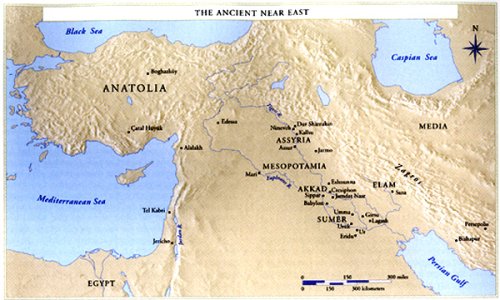
Ancient Scriptures
Ancient Mesopotamia is the area
corresponding to modern-day Iraq and to a lesser extent north-eastern
Syria, south-eastern Turkey and smaller parts of south-western Iran. It
is also known as the 'land of rivers" because it is located in
the area between the two rivers the Tigris and the Euphrates, which
were already mentioned as early as in the book "Genesis"
from the Tanakh (Hebrew Bible), that is known as "Bereesjiet"
in the Torah. The Tanakh was adapted later by Christianity in
the Old Testament and therefore its content is (with the exception of
a few passages from the Book of Daniel which had been written in
Aramaic) hardly different from the original Old-Hebrew text. The
books are ordered differently however.

Map
of the ancient near east
Certain
ancient Mesopotamian myths, including the myths of the Sumerians,
Akkadians, Assyrians and Babylonians, have remarkable similarities
with the stories of the Tanakh and the Old Testament. It is known
that these ancient Mesopotamian stories are much older and sometimes
even explained in much more detail. For example: The story about the
person
Utnapistim from the Gilgamesh epic is very similar to the flood story
that is mentioned in the book of Genesis in the Bible and the Tanakh.
This would imply that, "Bible stories", probably
would have their roots in those earlier myths - instead of a
diversion, what often had been thought.
The Bible is
essentially a compilation of ancient texts, selected by the
early church fathers. These texts deeply illustrate the beliefs and
dogmas of an ancient culture. However, texts that people weren't
supposed to read - because they were not in accordance to the current
general Christian orthodox belief - were labelled as uncanonical and
were purposely left out in the Bible, and this includes all works
that were seen as apocryphal and Gnostic, like the "Book
of Enoch",
even though the canonical text Genesis
5:24 makes
a very shortly reference to this man called Enoch:
"Enoch walked with God; then he was no more, because God took him away."
The full version of the
book of Enoch was once thought to be lost, but fortunately this book
was later discovered again within the Ethiopian version of the Bible,
where this book never had been excluded.
 In
the year 1945 there had been found a large jar within the
ruins of an ancient monastery in the Egyptian place called Nag Hammadi.
Within this jar there were found manuscripts that dated from the early
days of Christianity, which are now known as the Nag Hammadi codices.
Besides the well-known stories from the New Testament there were also
found ancient writings that had never been found before, like the
Gospel of Mary Magdalene and the Gospel of Thomas. These texts
were never included to the Bible because the Christian church saw the
contents of these gospels as typical Gnostic, and Christian orthodox
belief does not acknowledge Gnostic views and concepts. (Gnosis means:
"knowledge".) Possibly,
one might think that it could affect the stability and integrity of
the Christian community as these books, which are still criticized
within the orthodox Christian community, were to be officially added
to the Bible.
In
the year 1945 there had been found a large jar within the
ruins of an ancient monastery in the Egyptian place called Nag Hammadi.
Within this jar there were found manuscripts that dated from the early
days of Christianity, which are now known as the Nag Hammadi codices.
Besides the well-known stories from the New Testament there were also
found ancient writings that had never been found before, like the
Gospel of Mary Magdalene and the Gospel of Thomas. These texts
were never included to the Bible because the Christian church saw the
contents of these gospels as typical Gnostic, and Christian orthodox
belief does not acknowledge Gnostic views and concepts. (Gnosis means:
"knowledge".) Possibly,
one might think that it could affect the stability and integrity of
the Christian community as these books, which are still criticized
within the orthodox Christian community, were to be officially added
to the Bible.
Already since in the days of early Christianity
there was the division between traditional Christianity and
Gnosticism. Just because the oldest known scriptures (the Nag Hammadi
codices) are typically Gnostisic in nature, it is clear that early
Christianity was originally much closer to the Gnostic teachings
compared to the traditional Christian teachings that at a certain
time became the national religion of Rome and which from there did
spread to other countries. The consequence was that the Roman
Catholic Church became a very powerful organization in a number of
European countries and its inhabitants - often followers of Pagan
nature religions - were forced to convert themselves to the new
religion of Christianity, otherwise one was sentenced to
death.
Within the traditional Christian conceptions of
God, there is an unbridgeable distance between man and God, what is
quite different in Gnosticism. The fundamental difference between the
traditional Christian view and Gnosticism is that in Gnosticism
everything and everyone is part of a total unity that is known in the
gnosticism as the "All", or "the Father". On a
certain level, Gnosticism and Buddhism are quite similar. Possibly,
this could be because of influences of eastern mysticism. Dutch
philosopher and translator, Bram Moerland, described some typical
Gnostic concepts (between quotation marks):
Like
a beam of light is related to the sun, so man is also related to
the Source.
We
have "the features of the Father".
We
are the "heirs of the
Father".
(Source: www.brammoerland.com/gnostiek)
Also
according to the traditional Christian community, is the Bible the
unchanging "Word of God" and there would never had been any
alterations in the Bible. There is however enough evidence that -
during the past centuries - many portions of the texts had been
omitted or changed. By comparing the texts from the modern day Bible
to the older versions from the Nag Hammadi writings it is actually
clear that the original texts differ from the later canon at many
thousands of points. (See for many examples the book (Dutch):
"Valsheid in geschrifte: de gespleten pen van bijbelschrijvers"
(2003) by Jacob Slavenburg.)
In fact, the part of the Bible we
know today as the New Testament is actually a translation based
on the Greek versions of these writings, as the original Hebrew and
Aramaic writings were believed to be lost until the Nag Hammadi
writings were discovered. We now know that the name "Jesus"
is actually a Greek "conversion" for the Aramaic/Hebrew
name: "Yeshua", as both names are verbal derivatives that
have the same meaning: "to rescue" or "to deliver".
This however does not have to mean that Yeshua" was
really his usual name by which he was called.
Since the discovery of the Nag Hammadi
writings it is clear that the church as institution is very a
conservative one that chooses to deny this kind of developments over
any progress that could possibly cause some change of their own
statements and visions. Possibly they think such changes would
destabilize the institution but it would appear that actually the
opposite is true; Many people lost faith in the Christian Church
because it is not receptive for progression, adaptation and
renovation, and as a result of this it does not blend that well in
these modern times of free thinking and freedom of belief.



